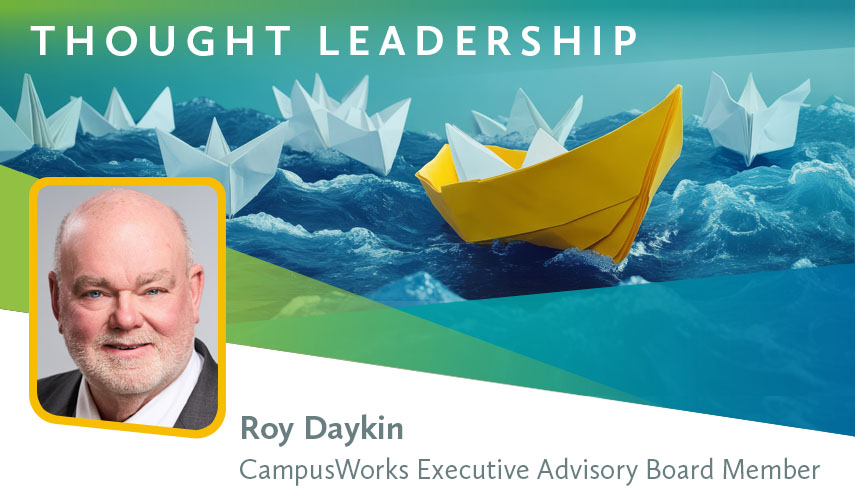
EAB Thought Leadership
Leading in Choppy Waters
What Canadian and U.S. CFOs See on the Horizon
By Roy Daykin, former CFO of Southern Alberta Institute of Technology and CampusWorks Executive Advisory Board Member
This summer I had the opportunity to attend two major gatherings of higher education business officers: the Canadian Association of University Business Officers (CAUBO) and the National Association of College and University Business Officers (NACUBO). Both conferences brought together CFOs and finance leaders to share ideas, wrestle with challenges, and consider what the future might look like.
Although the themes were similar, the tone could not have been more different. Canada’s conference carried a spirit of cautious optimism, while the U.S. gathering felt more somber, with many openly questioning the sustainability of the current model of higher education.

The Canadian View: Adapting to the New Normal
At CAUBO, the prevailing attitude was that choppy waters are here to stay — but institutions will adjust. The challenges are real:
- Reduced International Enrollments: Government restrictions are cutting deeply, with some institutions facing 10–20% overall budget shortfalls and up to 60% reductions in tuition revenue.
- Funding Gaps: Governments are not funding inflation, leaving institutions to find efficiencies on their own.
- Faculty Pushback: Faculty leaders once opposed the growth of international students; now, facing the impact of reductions, they are upset at the financial strain.
- Leadership Instability: Government and the corresponding board change is creating an aura of lack of confidence in long term senior executive tenure, which inhibits real change.
Still, there was confidence that post-secondary institutions will adapt. Many schools are in the middle of finance modernization projects, implementing large systems, standardizing processes, and investing heavily in change management. These projects are less about technology and more about shifting culture and practice.
The big question in Canada is one of leadership. Will boards back institutional leadership when tough decisions need to be made, or will they bend to faculty pressure? The answer will shape how well institutions navigate the storm.
The U.S. View: A Somber Reckoning
At NACUBO, the mood was noticeably heavier. The sessions were strong, but the conversations in the hallways and among vendors carried a tone of concern — even pessimism — about whether higher education, as currently structured, can sustain itself.
Top issues included:
-
- Regulatory Headwinds: Federal policy changes, new reporting requirements, and the constant threat of funding cuts have shifted much of the focus to compliance.
- Leadership Instability: Trustees are becoming more political, presidential tenures are shorter, and governance structures feel increasingly fragile. Without stable leadership, adjusting to the future challenges is likely to be unsuccessful.
- The Demographic Cliff: Declining numbers of high school graduates are forcing institutions to rethink programs, delivery models, and even their size. The United States is only the latest country to be impacted by demographic changes. Leaders and faculty need to look at what has been done elsewhere.
What stood out to me was the deep concern that current governance and leadership structures may simply not be capable of adapting to the scale of change. This is not just a financial problem — it is a structural one.
Common Threads Across Borders
Despite the different tones, Canadian and U.S. CFOs share many of the same challenges:
-
-
- Public and political apathy towards post-secondary education. There is no longer unchallenged belief that higher education will lead to a better life.
- Enrollment pressures, whether from shrinking domestic pipelines or international restrictions.
- Budget shortfalls driven by stagnant public funding, declining enrollments, and rising costs.
- AI uncertainty, with leaders exploring potential uses while wrestling with governance, compliance, and trust.
- Leadership capacity, which may ultimately be the most important factor of all.
-
What We Can Learn From Each Other
Each country has something to offer the other:
-
- Canada’s lesson for the U.S.: Standardized processes, strong change management, and resilience in the face of long-term funding pressures.
- The U.S.’s lesson for Canada: A sharper awareness of regulatory risk, governance fragility, and the importance of preparing for systemic public policy change.
- The lesson for both: Incrementalism will not be enough. Rearranging the deck chairs is not a strategy. Institutions must align programs with demand, modernize finance and operations, and build cultures of trust that allow them to face difficult realities head-on.
Leading in Choppy Waters
As a CFO, I’ve come to believe that the greatest challenge we face is not the numbers on the page but the leadership choices behind them. Budgets, systems, and enrollments are important — but without courage, trust, transparency, patience, and collaboration, even the best plans will falter.
The waters ahead are rough and likely to remain so. But turbulence also creates opportunity: to rethink outdated structures, to streamline and innovate, and to build institutions that are stronger, more transparent, and more resilient.
That’s what leadership in choppy waters requires. And it’s what our institutions — and our students — deserve.
Private Executive Coaching
If you’re interested in private executive coaching — or simply need a bit of trusted advice — CampusWorks’ Executive Advisory Board members are here to support you. Email us at transform@campusworksinc.com to schedule a time to talk.
Let’s Get Back To Happy
Contact us for more information, more understanding, and more days that run smoothly.


